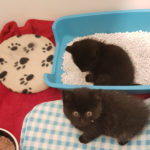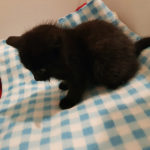Hello,
As a veterinarian I know I am biased BUT I see lots of these and I always recommend fixing them. Ideally at the time of spay/neuter as they are already under general anesthesia. For me most of these are fairly quick, cheap and easy. I have a few blogs and I think even a storyline here I can share. I also think this is a surgery almost all general practitioners can do. The long term affects of NOT doing it far outweigh the downside to doing it. I find if you don’t do the surgery the eyelashes rubbing against the cornea causes chronic squinting (due to pain!), tearing (due to corneal trauma) and eventually it can cause vision impairment. I would love to see a picture of your kitties eyes. And I would love to hear the surgery estimate the vet gave you.
Krista










Hello,
First it is important to give yourself a very firm and big pet on the back. You have gone above and beyond and saved these kittens from a slow awful death. Next this isn’t a question about the colon this is a question about what is causing all of the clinical signs you are seeing. Ileus (slow or absent moving gi tract) has many many causes but something caused it. Probably has everything to do with the same something causing everything else you are seeing. There is a huge list of possible causes. Infection, congenital disease, malnutrition before they got to you. Infectious disease like rabies, etc etc. my recommendation is to stick with the basics of keeping them warm, fed, and treated for parasites (internal and external). After that (or before your preference often dictated by amount owner can spend) is to keep asking for second opinions and keep running. Diagnostics. I really applaud your dedication and I have to say as much as sometimes we try we just aren’t able to save them all. This is especially true with kittens. Which have been some of the most rewarding and most heart breaking of all the cases I have seen.
Hello,
thanks so much for your answer and the nice words. Malnutrition would be definitly possible, it’s nearly winter here and they were thin when we got them. Maybe it was too much for the gi tract after not getting much for some time.
What additional diagnostics would you have recommended to do? I think bloodworks could have been an option, but what parameters? Just the large profile or other tests (besides FIV/FelV)?
I added the xRay. I was only present at the ultrasound, where I couldn’t see air. The xRay shows air in the stomach and colon. But otherwise everything is just… filled – theres not really something visible. Kidney and Liver could be seen in the ultrasound and looked normal. The “swelling” on it’s belly is the fluid that wasn’t absorbed – altough it felt a bit harder that a fluid bubble under the skin usually does.
The other one is still fine, active and playing, starting to eat on it’s own. Purring and cuddly. Yesterday we got the 3rd littermate, the mother is nowhere to be found until now. I haven’t seen the new one eat yet, but it was hungry when i fed it with a syringe – and it liked it. So I’ll just feed it a bit too, just not as much. That’s also nice for bonding. But it ate what was in the trap – so it knows cat food. It’s still very afraid, so I guess it will mostly come outside when I’m not in the same room.
We also got another one, a little male that the fidners named Nero – same area but not same place – but same age (a bit younger possibly) and also black furred. But this one is in bad shape, too. Very calm and tired. Lying most of the time. It’s just skin and bones, dehydrated. I haven’t seen it eating or using the litter box yet – and since the other two use it and the towel it lays on is wet sometimes I think it doesn’t really go. But it is able to stand and walk – I think it’s just to tired/weak to do so without need. This one is also fed every 3-4 hours and gets fluids. I heard him sneezing, so maybe it’s getting cat flu.
All were treated against internal and external parasites and no diarrhea until now from the new ones.
Thanks again for taking your time to read my wall of text(s) and answering so detailed.